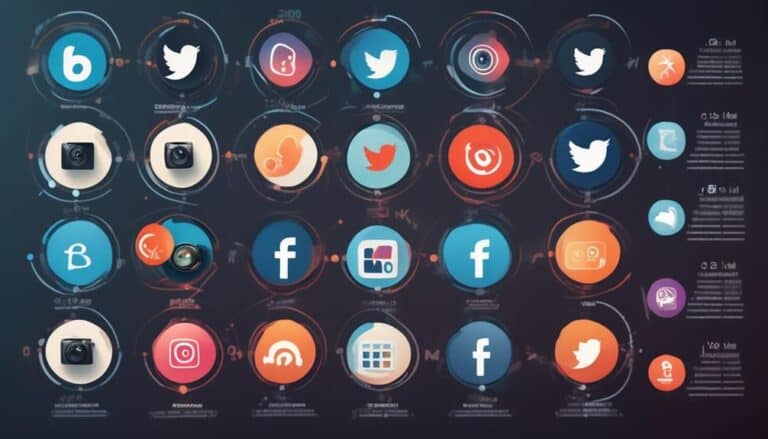Segmentation Secrets: How to Build and Nurture a Targeted Email List
Ever heard the saying, 'Quality over quantity'? When it comes to your email list, this phrase holds a significant truth. Building and nurturing a targeted email list through segmentation is akin to crafting a finely tailored suit – each piece meticulously designed to fit perfectly.
As you navigate the intricate landscape of audience segmentation, a world of possibilities and untapped potential opens up before you. Uncover the secrets to unlocking the true power of your email marketing efforts by mastering the art of segmentation, and watch as your campaigns reach new heights of effectiveness and engagement.
Key Takeaways
- Conduct thorough audience research to create detailed buyer personas for personalized messaging
- Optimize opt-in forms with personalized fields and interactive elements for increased effectiveness
- Analyze subscriber preferences and behavior to send personalized campaigns tailored to individual interests
- Utilize automation tools to streamline segmentation processes and deliver timely, targeted messages efficiently
Importance of Segmentation

Segmenting your email list is crucial for targeting the right audience with personalized content that drives engagement and conversions. By implementing audience segmentation, you can tailor your messaging to specific groups based on demographics, behavior, or preferences. This strategic approach allows you to send targeted messages that resonate with each segment, increasing the likelihood of capturing their interest and ultimately converting them into loyal customers.
Effective audience segmentation enables you to craft personalized campaigns that speak directly to the needs and interests of different groups within your email list. By understanding the unique characteristics of each segment, you can deliver relevant content that's more likely to generate a positive response. This targeted messaging not only improves engagement rates but also enhances the overall customer experience, leading to higher satisfaction levels and increased brand loyalty.
Innovative businesses recognize the power of audience segmentation in optimizing their email marketing efforts. By leveraging this strategy to deliver tailored content to specific segments, you can drive better results and achieve your marketing objectives more effectively.
Identifying Target Audience
To optimize your email marketing campaigns, pinpointing your target audience is a foundational step that lays the groundwork for tailored messaging and heightened engagement. Understanding your audience through in-depth research is key to crafting effective targeting strategies. Here are three crucial steps to identify your target audience:
- Conduct Audience Research: Utilize surveys, social media analytics, and website data to gather insights into your audience's demographics, preferences, and behaviors.
- Create Buyer Personas: Develop detailed profiles that represent your ideal customers based on the research findings. This helps in personalizing your messaging and content.
- Segment Your Audience: Divide your audience into smaller groups based on shared characteristics like age, location, or buying habits. This allows you to deliver more relevant and targeted content.
Data Collection Strategies

To build a strong email list, focus on optimizing your opt-in forms to increase effectiveness.
Analyze subscriber preferences to tailor your content and improve engagement.
Ensure compliance with privacy policies to build trust with your audience and safeguard their information.
Opt-In Forms Effectiveness
Enhancing your opt-in forms' effectiveness through strategic data collection techniques can significantly boost your email list growth. To optimize your opt-in forms for better results, consider the following strategies:
- Personalization: Tailoring form fields based on user preferences can increase opt-in conversion rates.
- Interactive Elements: Adding interactive elements like quizzes or polls can engage users and encourage them to subscribe.
- Mobile Optimization: Ensure your form layout is mobile-responsive for a seamless user experience on all devices.
Subscriber Preferences Analysis
Boost your email list growth by delving into subscriber preferences through strategic data collection strategies. Behavior tracking and segmentation analysis are key components in understanding what your subscribers want. By analyzing how subscribers interact with your emails, website, and content, you can tailor your messages to their preferences effectively.
Use tools like email analytics, heatmaps, and surveys to gather valuable insights into subscriber behaviors. Segment your email list based on these preferences to send targeted and personalized campaigns that resonate with each subscriber. Continuously monitor and adapt your strategies based on the data collected to ensure high engagement and conversions.
Stay ahead of the competition by staying attuned to your subscribers' preferences through robust data collection methods.
Privacy Policy Compliance
By implementing robust data collection strategies, you can ensure that your email list growth aligns with privacy policy compliance standards. To maintain GDPR compliance and stay current with privacy policy updates, consider the following:
- Transparency is Key: Clearly communicate to subscribers how their data will be used and stored.
- Opt-In Processes: Implement clear opt-in processes to ensure subscribers willingly agree to receive communications.
- Data Security Measures: Prioritize data security by implementing encryption and secure storage practices.
Ensuring your data collection practices align with privacy policy regulations not only builds trust with your audience but also protects your organization from potential legal implications. Stay proactive and transparent in your approach to maintain compliance and foster a positive relationship with your subscribers.
Implementing Segmentation Tools

To effectively reach your audience, implementing segmentation tools is crucial. Personalizing content for subscribers, tailoring emails for engagement, and utilizing data effectively are key components of successful email marketing strategies.
Personalizing Content for Subscribers
Implementing segmentation tools in your email marketing strategy is crucial for personalizing content and maximizing engagement with your subscribers. To enhance your email personalization strategies, consider the following:
- Behavior-Based Segmentation: Tailor content based on how subscribers interact with your emails or website.
- Demographic Segmentation: Customize emails according to factors like age, location, or gender.
- Purchase History Segmentation: Send targeted content based on past purchases or browsing history.
Tailoring Emails for Engagement
Enhance your email engagement strategies by strategically utilizing segmentation tools to tailor content for your subscribers' preferences and behaviors. By implementing advanced segmentation techniques, you can optimize your email campaigns for higher engagement rates.
Use engagement tactics such as personalized recommendations based on past interactions or dynamic content customization to create a more personalized experience for your subscribers. Segmenting your email list allows you to send targeted messages that resonate with specific audience segments, increasing the likelihood of driving conversions.
Experiment with different segmentation criteria to identify what works best for your subscribers and refine your content accordingly. By focusing on tailoring emails for engagement, you can build stronger connections with your audience and boost the overall effectiveness of your email marketing efforts.
Utilizing Data Effectively
As you optimize your email campaigns for higher engagement rates through advanced segmentation techniques, leveraging data effectively is key in tailoring content for your subscribers' preferences and behaviors.
To implement segmentation tools successfully, consider the following:
- Data Optimization: Ensure your data is accurate, up-to-date, and relevant to gain insights that drive targeted messaging.
- Personalization Strategies: Use data points such as purchase history, browsing behavior, or demographics to create personalized content that resonates with each segment.
- Automation Tools: Utilize automation to streamline the segmentation process and deliver timely, targeted messages to the right audience segments efficiently.
Personalization Techniques

To effectively personalize your email campaigns, consider utilizing dynamic content that adapts to each recipient's preferences and behaviors. By incorporating customization options and creating segmented campaigns, you can tailor your messages to resonate with your audience on a deeper level. Customization options allow you to address your subscribers by their names, recommend products based on their previous purchases, and send personalized offers that match their interests. This level of personalization helps build a stronger connection with your subscribers, leading to higher engagement and conversion rates.
Segmented campaigns further enhance your personalization efforts by dividing your email list into specific groups based on demographics, behaviors, or interactions with your brand. This enables you to send targeted content that's more relevant to each segment, increasing the likelihood of recipients engaging with your emails. By analyzing the data collected from these segmented campaigns, you can continuously refine your email marketing strategy to better meet the needs and preferences of your subscribers. Embracing personalization techniques not only improves the effectiveness of your email campaigns but also showcases your brand's commitment to delivering value to your audience in a personalized manner.
Automation Benefits
Automate your email marketing processes to streamline workflows and maximize efficiency in targeting and engaging with your audience. Email automation offers a plethora of benefits that can revolutionize your email marketing strategy. Here are three compelling reasons why you should incorporate email automation into your campaigns:
- Enhanced Personalization: Leverage email automation to send targeted campaigns based on user behavior, preferences, and demographics. Tailoring your content to specific segments of your audience increases engagement and conversion rates.
- Time-Saving Efficiency: Automating repetitive tasks such as sending welcome emails, follow-ups, and reminders frees up valuable time for your team to focus on creating high-quality content and analyzing campaign performance.
- Consistent Communication: With email automation, you can maintain a consistent presence in your audience's inbox without having to manually send each email. This ensures that your subscribers receive timely and relevant content, nurturing strong relationships with them over time.
Embrace email automation to elevate your email marketing efforts and drive meaningful results through targeted, efficient campaigns.
Engagement Metrics Tracking

By implementing email automation to streamline your workflows and enhance targeting, you can now shift focus towards tracking engagement metrics to optimize your email marketing strategy further.
Monitoring metrics such as open rates, click-through rates, conversion rates, and bounce rates is crucial for gauging the effectiveness of your email campaigns.
Open rates indicate the percentage of recipients who opened your email, providing insight into the initial appeal of your subject lines and sender name.
Click-through rates measure the percentage of recipients who clicked on links within your email, showing the level of interest and engagement with your content.
Conversion rates reveal the number of recipients who took the desired action after clicking through, whether it's making a purchase, signing up for a webinar, or downloading a resource.
Lastly, bounce rates help identify delivery issues and the quality of your email list by showing the percentage of emails that were undeliverable.
Utilizing these metrics will enable you to refine your email strategies and tailor content to better resonate with your audience.
Continuous List Refinement
For enhancing the effectiveness of your email marketing campaigns, refining your email list continuously is a strategic imperative. By honing in on list segmentation and audience profiling, you can ensure that your messages are targeted and relevant to your subscribers.
Here are three key strategies to refine your email list effectively:
- Regularly Review and Update Segments: Keep your list segmentation up to date by analyzing engagement metrics and adjusting your segments based on subscriber behavior.
- Implement Progressive Profiling: Continuously gather more information about your subscribers over time to create detailed audience profiles and tailor your content accordingly.
- Monitor and Cleanse Inactive Subscribers: Regularly check for inactive subscribers and consider re-engagement campaigns or removing them from your list to maintain a healthy and engaged audience.
Frequently Asked Questions
How Can I Effectively Combine Different Segmentation Strategies to Create a Highly Targeted Email List?
To effectively combine different segmentation strategies for a highly targeted email list, focus on behavioral targeting and demographic analysis. Enhance user engagement by delivering content relevant to their preferences. This approach maximizes audience connection and conversion rates.
What Are Some Creative Ways to Collect Data Beyond Traditional Methods for Segmentation Purposes?
To enhance your segmentation strategy and gather valuable insights, explore data enrichment for a deeper understanding. Utilize behavioral targeting to tailor content. Engage in social listening for real-time feedback and predictive modeling to anticipate future needs.
Can You Provide Examples of Advanced Personalization Techniques That Go Beyond Just Using the Recipient's Name in Emails?
To enhance personalization beyond basics, consider behavioral targeting to tailor content based on actions. Use dynamic content to adjust emails in real-time, showcasing products of interest. By implementing these advanced techniques, engagement and conversion rates can soar.
How Can I Ensure That My Automated Emails Maintain a High Level of Engagement With My Segmented Audience?
To ensure high engagement in your automated emails, implement personalization strategies tailored to segmented audiences. Use data collection techniques to understand their preferences. Employ interactive content, exclusive offers, and personalized recommendations as engagement tactics.
What Are Some Common Pitfalls to Avoid When Refining and Updating My Email List Over Time?
To refine and update your email list effectively, prioritize engagement metrics and feedback loops. Maintain list hygiene for optimal email deliverability. Avoid common pitfalls like neglecting to segment, overlooking unsubscribed contacts, and failing to address inactive subscribers promptly.
Conclusion
Now that you have learned the secrets of segmentation, you can take your email marketing to the next level.
By identifying and targeting your audience, collecting data strategically, and implementing segmentation tools, you can personalize your emails and automate your campaigns for maximum engagement.
Remember to track your metrics and continuously refine your email list to ensure success.
Start building and nurturing your targeted email list today for a more effective and efficient email marketing strategy.








